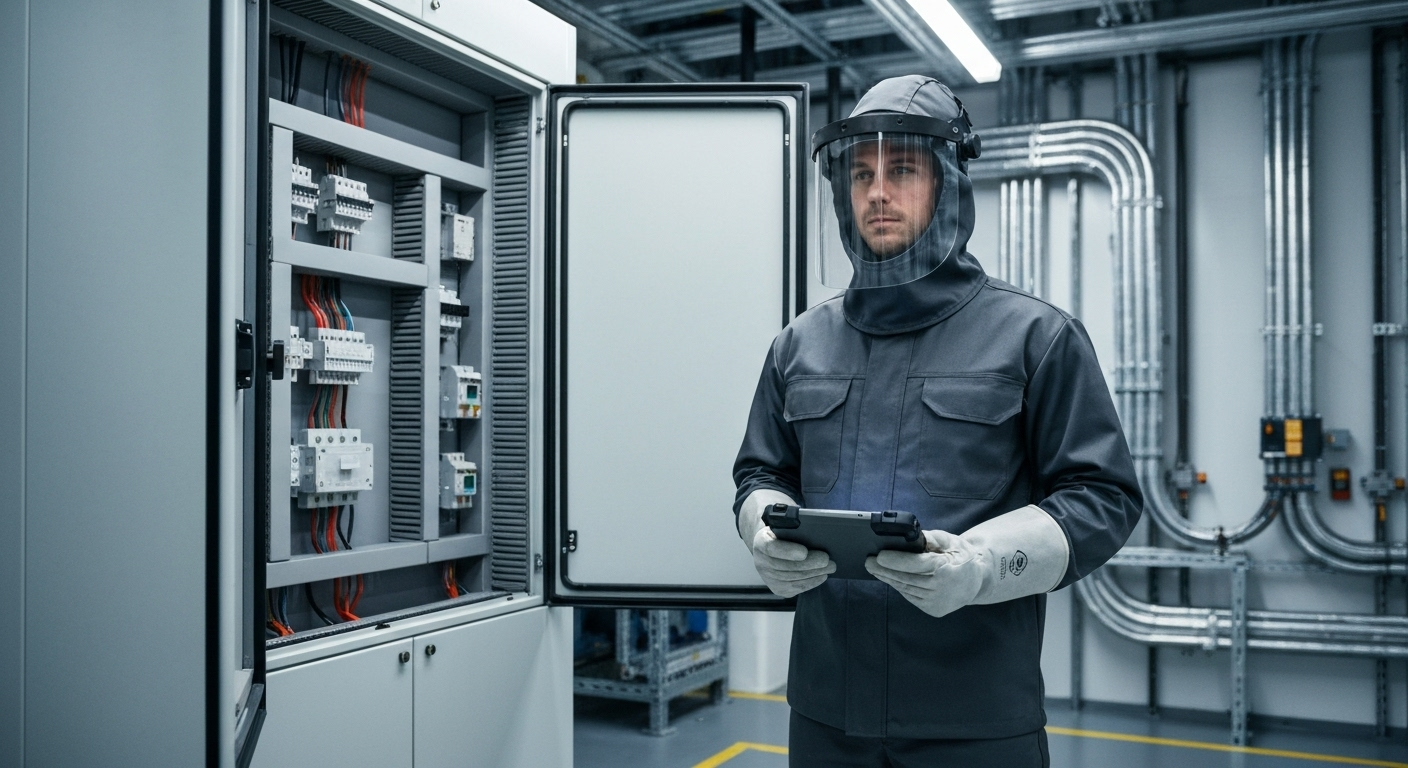
NFPA 70E 2024: Arc Flash PPE Updates Every Electrician Should Know
NFPA 70E 2024: Arc Flash PPE Updates Every Electrician Should Know
Summary: Key NFPA 70E Arc Flash PPE 2024 Changes
The 2024 edition of NFPA 70E, Standard for Electrical Safety in the Workplace®, introduces critical updates to personal protective equipment (PPE) requirements that every qualified electrician must understand. The most significant change is the explicit requirement for arc flash hearing protection whenever there is a recognized arc flash hazard, addressing the danger of hearing damage from the arc blast’s pressure wave. The standard also clarifies conformity assessment, now requiring employers to verify that arc-rated (AR) and voltage-rated equipment from manufacturers complies with standards like ASTM F1506. Additionally, the 2024 update refines balaclava requirements, stating a balaclava (sock hood) must be used with an arc flash hood for all head and neck protection unless the hood itself provides full coverage. These updates reinforce the industry’s move towards more stringent electrical safety compliance and risk mitigation.
The Foundation: Why NFPA 70E Compliance Matters for Electrical Safety
As a master electrician and instructor, I can’t overstate this: understanding NFPA 70E isn’t just about passing an exam; it’s about going home safely at the end of every shift. While the National Electrical Code (NEC) dictates *how* to install systems safely, NFPA 70E dictates how to *work* on them safely. The core mission of the standard is to protect us from the severe, often life-altering dangers of shock, electrocution, arc flash, and arc blast. For a deep dive into the latest standards, explore our complete guide on the latest NFPA 70E 2024 arc flash PPE standards.
Revisiting the Hierarchy of Risk Controls
Before we even discuss PPE, the 2024 edition continues to emphasize the hierarchy of risk controls. PPE is, and always will be, the last line of defense. The preferred methods for mitigating risk, in order, are:
- Elimination: The most effective method. This means de-energizing the equipment. An Energized Electrical Work Permit (EEWP) is required for most energized work, reinforcing that de-energization is the default.
- Substitution: Using less hazardous equipment or processes.
- Engineering Controls: Implementing physical changes like arc-resistant switchgear.
- Awareness: Signage, labeling, and training.
- Administrative Controls: Safe work practices and procedures.
- PPE: The gear you wear to protect yourself when a residual risk still exists.
Your safety program must prioritize these controls in this order. Only after exhausting higher-level options do we turn to selecting the appropriate arc-rated clothing and equipment.
Major 2024 Updates to Arc Flash PPE Requirements
The 2024 cycle brought several refinements focused on closing safety gaps. Here are the most critical NFPA 70E 2024 changes you need to incorporate into your daily electrical safety-related work practices.
The New Emphasis on Arc Flash Hearing Protection
This is arguably the most impactful change in the 2024 edition. Section 130.7(C)(5) now explicitly states that for workers within the arc flash boundary, hearing protection is required. Previously, the need was implied but not mandated. The standard now recognizes that the pressure wave (arc blast) from an arc flash event can be intense enough to cause permanent hearing damage, even if no thermal injury occurs.
This means hearing protection (e.g., ear canal inserts, earmuffs) is now a standard part of the arc flash PPE ensemble, just like your AR shirt or voltage-rated gloves with leather protectors.
Clarifying Conformity Assessment for Arc-Rated Clothing (ASTM F1506)
How do you know the gear you’re buying actually meets the standards it claims to? The 2024 update addresses this head-on by strengthening the language around conformity assessment. Article 130.7(C)(14) now requires the employer to implement a process to ensure that any PPE, including arc-rated clothing, meets the relevant standards (like ASTM F1506 for AR textiles).
This places a greater responsibility on the employer to not just buy equipment, but to verify its legitimacy. This may involve requesting documentation from the manufacturer or using third-party certified products. The goal is to eliminate counterfeit or substandard gear from the field.
Updated Balaclava Requirements for Complete Head Protection
There has long been confusion about when an arc-rated balaclava (sock hood) is needed. The 2024 revision to 130.7(C)(1) clarifies this. When your work requires an arc flash suit hood, you must also use a balaclava unless the hood *itself* provides full 360-degree coverage for the head and neck, including the chin and throat area. Most standalone hoods have gaps around the neck. Therefore, for nearly all applications requiring a full hood, a balaclava is now a mandatory under-layer to ensure no skin is exposed.
A Step-by-Step Guide to Selecting Arc Flash PPE
There are two methods for selecting arc flash PPE: the Incident Energy Analysis Method and the PPE Category Method. The incident energy analysis is the more precise and preferred method.
Using the Incident Energy Analysis Method
An incident energy analysis, performed by a qualified engineer, determines the exact energy (in cal/cm²) a worker could be exposed to at a specific working distance. This value is printed on the arc flash label.
Here’s how a qualified person uses that information to select PPE:
- Consult the Arc Flash Label: Before approaching the equipment, read the label to identify the calculated incident energy and the arc flash boundary.
- Determine the ATPV Requirement: The Arc Thermal Performance Value (ATPV) of your PPE must be greater than the calculated incident energy. For example, if the label says 10 cal/cm², your PPE system must have an ATPV rating higher than 10 cal/cm².
- Select a Complete System: Assemble a full PPE system where every component meets the required ATPV. This includes your shirt, pants/coveralls, hood, gloves, and face shield. Remember, the rating of the system is only as good as its weakest link.
- Include New Mandatory Items: Add the newly required arc flash hearing protection. Check if a balaclava is needed based on your head/neck protection.
- Perform PPE Maintenance and Inspection: Before every use, thoroughly inspect all gear for damage, defects, or soiling that could compromise its protective properties.
Understanding system design is crucial for this analysis. The available fault current, a key input, can be influenced by factors like how the 2023 NEC updates impedance grounding system requirements, which can significantly alter potential incident energy.
Practical Implications for the Qualified Person in the Field
These changes mean you need to be more vigilant than ever. Your daily toolbox talk should now include a reminder about hearing protection. When ordering new gear, you or your supervisor must be asking for conformity documentation. This heightened sense of responsibility is at the heart of modern electrical safety compliance. Remember that even seemingly basic tasks are governed by complex rules; for instance, while NFPA 70E covers safety, the NEC still governs fundamental installation practices like how to calculate junction box size with terminal blocks.
PPE Maintenance and Inspection: A Non-Negotiable Practice
Having the right PPE is only half the battle. Maintaining it is just as critical. The 2024 standard continues to emphasize proper care and maintenance.
- Cleanliness: Soiling, especially with flammable contaminants like oil or grease, can negate the arc-rated properties of your clothing. Follow manufacturer instructions for cleaning.
- Inspection: Before each use, inspect for rips, tears, burn holes, or worn-out areas. Damaged PPE must be retired from service.
- Storage: Store PPE in a clean, dry location away from sunlight and physical damage.
- Voltage-Rated Gloves: Remember that voltage-rated rubber gloves must be field air-tested before each use and dielectrically tested periodically (every 6 months for gloves in service).
Staying current with these evolving standards is essential for every professional. To deepen your understanding of these critical safety updates, Learn more with ExpertCE, your trusted partner for electrician continuing education.
Primary Sources for Electrical Safety Compliance
For official information and to purchase the standard, always refer to the source:
- National Fire Protection Association (NFPA): NFPA 70E®, Standard for Electrical Safety in the Workplace®
Frequently Asked Questions about NFPA 70E Arc Flash PPE 2024
- 1. What is the biggest NFPA 70E 2024 change for arc flash PPE?
- The most significant change is the new, explicit requirement for arc flash hearing protection (e.g., earplugs or earmuffs) for any worker within the arc flash boundary. This addresses the hazard of acoustic shock and pressure wave damage from an arc blast, which was previously an often-overlooked risk.
- 2. How does the new conformity assessment requirement affect the arc-rated clothing I buy?
- The 2024 update requires employers to have a process to verify that their purchased arc-rated clothing and other PPE meet the claimed standards, such as ASTM F1506. This means you may see employers asking for more detailed compliance documentation from manufacturers to ensure the gear is legitimate and not counterfeit, increasing overall trust and safety.
- 3. Do I always need a balaclava (sock hood) under my arc flash hood?
- According to the 2024 clarification, you must wear an arc-rated balaclava with an arc flash hood unless the hood itself provides complete 360-degree protection for the head and neck. Since most traditional hoods have gaps around the neck, the practical answer is yes, a balaclava is almost always required with a hood to ensure full protection.
- 4. Is the PPE Category Method still valid in NFPA 70E 2024?
- Yes, the PPE Category Method (using tables 130.7(C)(15)(a), 130.7(C)(15)(b), and 130.7(C)(15)(c)) is still a valid, simplified approach for selecting PPE when an incident energy analysis is not available. However, NFPA 70E prioritizes the incident energy analysis method as the more accurate and definitive approach to electrical safety compliance.
Advance Your Expertise with ExpertCE
The electrical industry is constantly evolving, and your commitment to safety must evolve with it. The NFPA 70E arc flash PPE 2024 updates are a critical part of that evolution. Staying compliant isn’t just a requirement—it’s a professional responsibility that protects you and your colleagues.
Ensure your knowledge is up-to-date and compliant with the latest codes and standards. Enroll in your CE course today, visit ExpertCE and continue to be a leader in electrical safety.
Disclaimer: The information provided in this educational content has been prepared with care to reflect current regulatory requirements for continuing education. However, licensing rules and regulations can vary by state and are subject to change. While we strive for accuracy, ExpertCE cannot guarantee that all details are complete or up to date at the time of reading. For the most current and authoritative information, always refer directly to your state’s official licensing board or regulatory agency.



